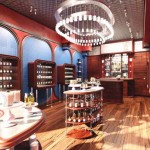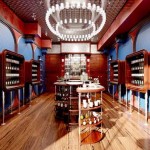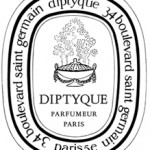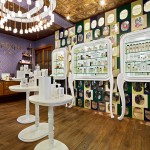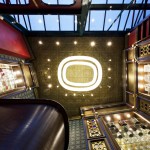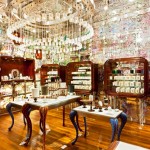No stranger to high-end boutiques, Wicker Park embraces its newest competitor, Parisian shop diptyque. With boutiques in Paris, London, Hong Kong, Dubai and New York diptyque has created a worldwide persona of sophistication.
The locations designer, Christopher Jenner captures foreign elegance fit for a king in his newest creation. Recently awarded British Breakthrough Talent of the Year at the FX International Design Awards, in the increasingly competitive world of retail design Jenner conquers historical luxury in his newest endeavor.
When it came to their newest location, Jenner was the obvious choice. “We are to once again partner with Jenner Studio,” Donna DiDonato Managing Director, diptyque USA said. “We felt that Wicker Park captured the spirit of the first boutique and fit in perfectly with our brand’s aesthetic.”
Originally started by three colleagues at Ècole des Beaux Arts in Paris, Christiane Gautrot an interior designer, Desmond Knox-Leet a painter and Yves Coueslant a set designer have branded their company in an unparalleled way. From the very start, the three captured the stylish bazaar of their world travels not only in the products they carried and the diptyque boutiques.
The original store opened in Paris in 1961. Intended to show off the three artists fabrics and other design works, It was not until 1963 that the merchants being to carry handmade candle and their luxury fragrances. Today, the diptyque brand label remains to be one of the most iconic labels in French retail history.
According to Jenner Studio, “Applying our unique ‘fractal analysis’ to diptyque we marry the brand with classic Victorian Architectural and Design heritage to create an interior space inspired by English patterning and French luxury.”
In addition to French and English influences, the newest Chicago boutique features wallpaper and fabric designs inspired by Native American tribes from the Chicago area Potawatomi Indians. Amongst the 200 hand-painted mirrors that line the walls of the New York Bleeker Street location, one will also find beading and basketry from the Mohawk tribe. Weaving their history in his designs, Jenner uses original diptyque fabric designs in all his locations.
Upon entering the boutique, it is clear that Jenner has once again encompassed the unique elegance of the luxury brand while juggling intricate and historical designs. Ceiling to floor the designer redefines perfection as the new location includes a breathtaking double-halo stainless steel chandelier featuring diptyque candles and a dark wood Austrian oak floor.
Through his mastery of design, it is evident diptyque is just the beginning for Jenner. After graduating from the Johannesburg School of Art and the Boston School of Design in Cape Town, Jenner moved to London to begin designing. Attributing his inspiration from growing up in South Africa, he also incorporates his Buddhist beliefs in the designs of his brand. Today, as the head of Christopher Jenner Studio in London he inspires visionaries to push the envelope and embrace beauty.
When did you know you wanted to be a designer?
Jenner: I’m a firm believer in process; it’s about the journey rather than the destination. While I’ve had an excellent foundation education in art and design, I never set out to be a designer per se, it seemed like too big a mountain to climb so I scaled each challenge one at a time. As a designer you never really reach the destination.
How has growing up in South Africa influenced you as a designer? What does it
bring to your style?
Jenner: Color form and freedom, I think designers from the emerging world are less constrained by heritage and find it easier to play with varied concepts and ideas.
How would you describe your process?
Jenner: What makes my process unique is the ability to design through words, allowing words to define various concepts and ideas and developing design schemes around these. This results in a more strategic, rather than indulgent, approach to the work.
What design elements are important to incorporate in all the diptyque
locations and why?
Jenner: Pattern is the essential element to all diptyque locations, it reflects a shared heritage and lies at the heart of the brand origin. The brand founders were textile designers passionate about graphic representations of culture, therefore the solution was to marry local culture with pattern, creating justified unique experiences each time.
How did you embody the diptyque’s history and heritage through your
designs?
Jenner: We have used the brand iconography through out the structural elements in the design, from the halo chandelier to the half oval tables. Diptyque heritage pattern and stories are integrated into the stainless steel etched storyboards and the surface elements in the freestanding furniture.
In the Chicago store you were inspired by Native American tribes from the Chicago area, where did this inspiration seed from? And how did you obtainthe materials for your creations?
Jenner: Our design proposition for the brand is firmly based on incorporating local culture alongside the brand presentation, this stems from a shared passion for indigenous cultures of the brand founders. Most of the inspiration pieces are from the Smithsonian Institute and include Miami, Illinois, and Potawatomi Indians and include basket work, bead work and daily items.
What were some of your main influences in the Chicago store design?
Jenner: Capturing the graphic nature of the city skyline was essential to the design process, quite by chance this aspect fitted perfectly with Native American hand craft which is also extremely graphic in design. We also used lots of solid and crafted metal reflecting the architectural heritage of Chicago.
What do you believe is the importance in retail design in these times?
Jenner: A few years ago there was a real fear of the retail landscape disappearing, however the reverse has happened, we see an ever increasing investment in statement flagship spaces, with a dual use of brand communication and sales. The emotion of space has ensured the survival retail design. Additionally retail design
is coming into it’s own, it’s the main point of design reference for the largest part of the population.
What’s next?
Jenner: Our next projects are in London, Paris and Singapore.
Being as successful as you are, do you have any advice for future designers?
Jenner: Hard work and passionate belief are the essential building blocks to a successful studio. Define a USP from the start and get working!
For More Information on Christopher Jenner Studio:
http://www.christopher-jenner.com/
diptyque Chicago 1645 North Damen Avenue Chicago, IL 60647
Click To View Images:
Article Written by: Emma Watson



